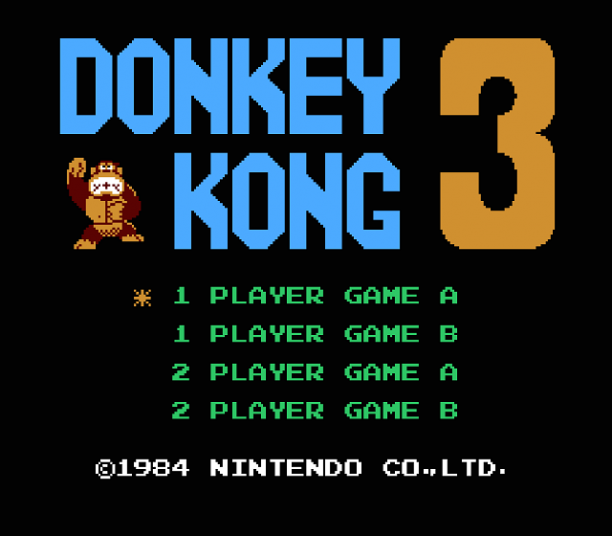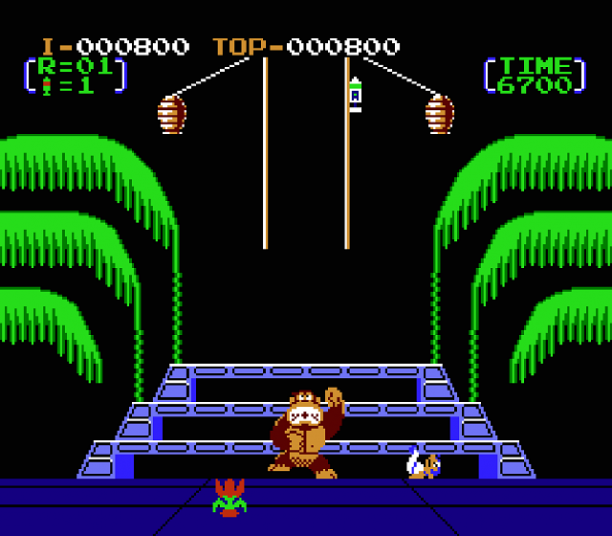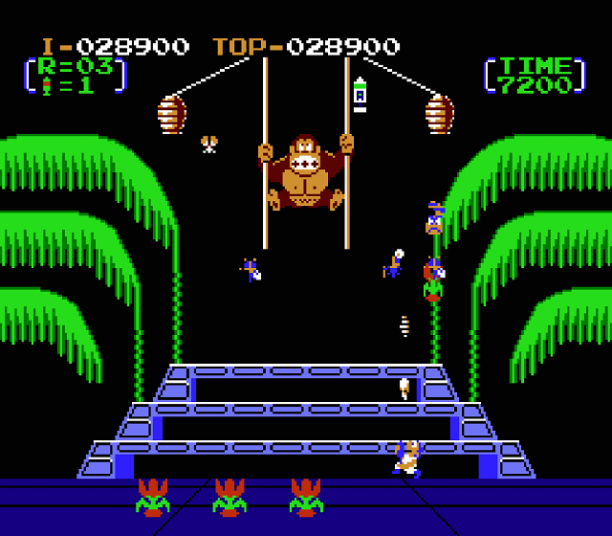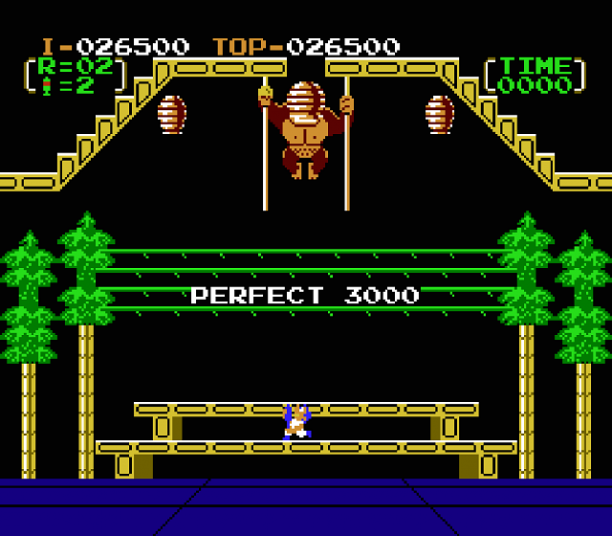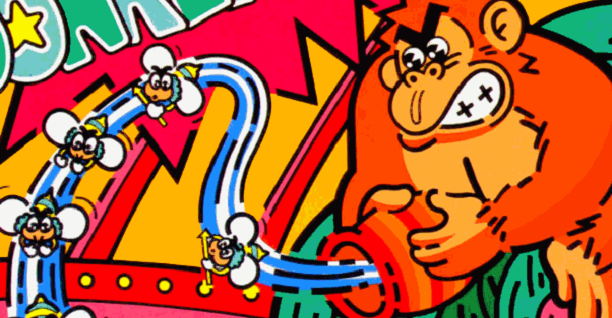
Pixel Gallery
Donkey Kong 3
Retro Platforms: Arcade, FM-7, Nintendo Entertainment System, PC-88
Platform Reviewed: Nintendo Entertainment System
Mario seems to be one of Nintendo’s most popular mascots, despite being a plumber who eats random mushrooms, murders innocent turtles, and presumably gets dirty by running through sewers. Some of his earliest appearances were in the first two Donkey Kong arcade games, where he goes from rescuing his captive girlfriend to cruelly imprisoning a giant ape, the latter which involves leaving a young child out in the world to fend for himself! In contrast to Mario, Stanley the gardener is a much more likable character: he grows beautiful flowers and cares for nature first, also not being afraid to defensively attack his enemies directly… with endless amounts of bug spray! Stanley may go after bugs, which are needed for his flowers to properly grow, but only when they try to fly away with his plants… because bugs are somehow capable of this. Donkey Kong 3 introduces a radically different style of gameplay to the classic arcade series, featuring the florist’s attempts to ward off a lazy ape and his army of evil insects, but is it memorable? And how are the presentation elements?
Graphics
The absurd story of Donkey Kong 3 involves the title antagonist taking residence in Stanley’s greenhouse, and because the ape feels too lazy to move somewhere else, he decides to instead infect the place with swarms of flower-stealing bugs; the setting is conveyed convincingly in terms of its visual objects, although the backgrounds consist of just a single shade of black, which takes away from the art style some. Graphically, the stage objects are the highlights, which are easily distinguishable from one another as well as pleasant to look at due to their tropical and rich coloring; many of the colors serve as ideal complements to one another, and they honestly help with the game’s relaxing themes. There’s also a noticeable attempt at visual distance, with the floor lining moving into the screen to show room between Stanley and his flowers. Additionally, what I presume to be a multi-layered bench or decorated table has some limited shadow effects to imply three dimensions; it’s not too convincing due to the shape of the edges, but it’s an ambitious effort considering the hardware limitations.
Besides his satisfying bursts of bug spray, Stanley’s movements are also animated well: in addition to immediate feedback to running left and right, Stanley can leap or fall between different platform levels, something which is conveyed without awkwardly skipping any frames. Enemies are also smoothly drawn, having movements that match their species: examples include silkworms inching down hanging plants, and angry bees moving in circular motions. Donkey Kong particularly has an imposing look, complete with chest and facial details, as he slowly moves down two vines in a menacing manner; he also punches hives at the starts of levels to introduce bug-based drama, and getting his head stuck in a beehive looks really amusing. Gameplay-wise, all the details that the player needs to see are ideally placed, not being distracting from the gameplay: scores and life amounts are updated in real time, and remaining red flowers indicate point bonuses. If there’s another con to mention, it’s that the stage design, while very vibrant, is limited to three types, so it starts to lose its charm over time. Additionally, Stanley’s locked to facing upwards, which can look weird despite his legs properly animating.
Audio
The first stage theme is probably one of the more creative tracks in the game, mainly due to it providing dramatic ambiance instead of a catchy melody; it loops repeatedly and has a soft warping sound as well as insect-like noises, but it’s thankfully not loud to the point of being distracting. This song works best with how it rolls into the theme of a flower being taken away by an enemy, where a repeating alarm with a countdown effect continuously plays and immediately lets you know that one of your fellow flowers is in danger! Other tracks include a really invigorating power-up theme that plays while a weapon upgrade is active, an upbeat track that raises excitement in later levels, and a cautionary beat that warns you of Donkey Kong nearing the floor. Listened to by themselves outside of the game, the tracks can sound extremely repetitive and maddening, but they actually work pretty well when used for ambiance. The sound effects also get the job done, with distinct sounds playing in response to different gameplay actions, and short jingles happening after certain moments; none of them are really noteworthy, but aside from the sound of dying sounding a bit sharp, I can’t think of any major complaints.
Gameplay
Alternating between three different level layouts, there are two possible ways to complete each stage: pester Donkey Kong continuously enough until he reaches the top of the screen, or defeat every bug that he spooks out of two beehives. Both methods involve upwardly spraying bug spray, which you have unlimited amounts of at the cost of being limited to firing two shots at a time; they have a satisfying poof effect once they reach their range, and it’s very precise without there being any hit detection problems. In addition to choosing when to spray, you can also move sideways, jump up a height level, and jump down a height level; these last two don’t allow for horizontal movements, which seems to be an intentional design decision rather than an awkward restriction. In some instances, if you annoy Donkey Kong enough until he reaches near the stop of the screen, a power spray item falls: collecting it temporarily increases the distance and power of your shots, which is a fun reward, although it feels overpowered since it can last for multiple levels and end some stages too quickly.
Donkey Kong slowly lowers himself towards the bottom of the vines, and if he reaches the end, then he dramatically falls down and immediately defeats Stanley; it adds some creative tension to the presentation, and it being coupled with the intense swarms of smaller enemies makes you have to multi-task and consider what danger is more immediately concerning. To counter Donkey Kong’s hunger for cold-blooded murder, you can fire bursts of bug spray at him in order to shoo him up the vines; however, he will eventually start climbing down again, so it’s only a temporary defense. Where this system gets complex is how both sides can be equally offensive to one another: if you scare the ape high enough up the vines, then he’ll either flee the stage or get his head stuck in a (hopefully empty) beehive, commencing the next round. This mechanic makes it feel like you’re doing more than just extending a timer, and its back-and-forth nature actively engages the player!
Besides spraying toxic substances at an ape’s butt, you also have to avoid being hit by a varying number of bugs, because bugs are always the most dangerous creatures to have in a garden. Flies are common, hovering downwards while dropping projectiles and plotting to steal Stanley’s flowers. Silkworms are interesting enemies in that they can only be killed with power spray, but can be scared away by hitting them while they climb down plants; otherwise, hitting them temporarily stuns them, which can be pretty annoying if the worms block your paths to hitting Donkey Kong. It’s sometimes a viable strategy to avoid hitting silkworms so long as you avoid touching them, but that’s entirely up to you. Queen bees are particularly dangerous enemies: they have shields of circulating bugs around them, take two hits (visually indicated by color changes) to kill, and explode into four directions (always the same ones) upon being defeated. Later stages add darting bugs which horizontally dash across the screen after reaching your height: you have little dodging time from this, so keep a close eye on them!
There’s also a time limit for each life, but I never saw it as a serious threat and instead appreciated the incentive to quickly finish stages in order to earn higher point bonuses. Besides the clock and killing creepy-crawlies, you also receive points based on the number of red flowers that you have remaining at the ends of stages; in addition to protecting yourself, you’re also encouraged to stop certain bugs from somehow flying away with these individual flowers, which you can dramatically stop by shooting them down before they carry the plants too far away. The fact that the music gets intense while a flower is being stolen helps make these moments evidently clear that the thieves have seriously crossed a line! You also get a large perfect bonus for protecting every flower in a stage, and because points can give you extra lives, the dilemma of prioritizing personal safety versus a higher score adds another balance system to the gameplay. The biggest strength of Donkey Kong 3 is its active involvement of the player, never making any of their seconds while being in control feel slow or dragged out.
As fun as Donkey Kong 3 is in short bursts, however, its appeal feels more limited with regards to longer-term play sessions. For starters, although new bugs are added and the difficulty increases over time, there are only three stage designs that only slightly change up the main gameplay: one level with an airborne musical sheet makes the silkworms more actively annoying, and another level removes part of the bench’s middle in order to make defeating Donkey Kong require more movements to reach. The fundamental gameplay remains the same though, and because stages can be finished in less than half a minute, the action starts to feel a little repetitive after a while. A smaller complaint that I neglected to mention goes towards a rare attack where the ape hurls coconuts at you: the throwing is quick and doesn’t always give you much time to respond if you’re on the bench’s highest point. Aside from these limitations, the gameplay is actually pretty fun and inventive, and the overall variety is further helped by there being both a higher difficulty mode and well as an alternating two-player mode!
Conclusion
It’s strange to see the third Donkey Kong game have such a radical departure in terms of gameplay, but it has an actively engaging premise that’s also fun to play out! I particularly like the various balance mechanics that run in real time, and the controls are responsive. Donkey Kong adds intensity, the bugs add variety, and the flowers add elements of greed. And aside from some smaller complaints, the only major issue with the gameplay is its limited long-term appeal, which makes Donkey Kong 3 something that you might play every now and then instead of frequently. As for the presentation, the tropical coloring is pleasing to look at despite the lack of backgrounds, the animation is fairly smooth, and the soundtrack overlays ambiance onto the experience. If you want a short yet fun arcade game, or if you feel like slaughtering pesky bugs, then you can’t go wrong with Donkey Kong 3!
